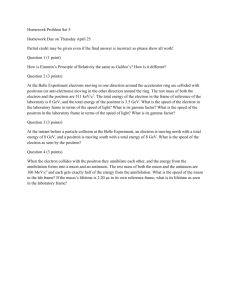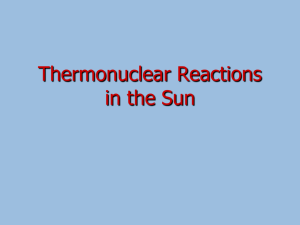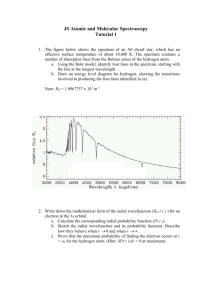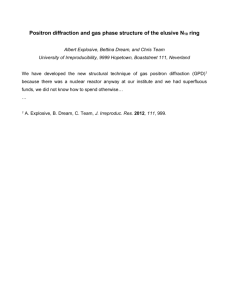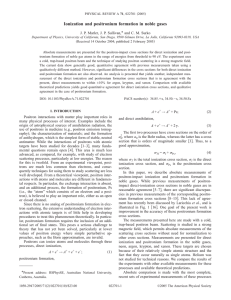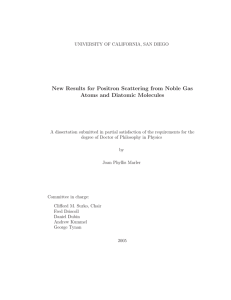High resolution cross section measurements J. P. Marler and C. M. Surko
advertisement
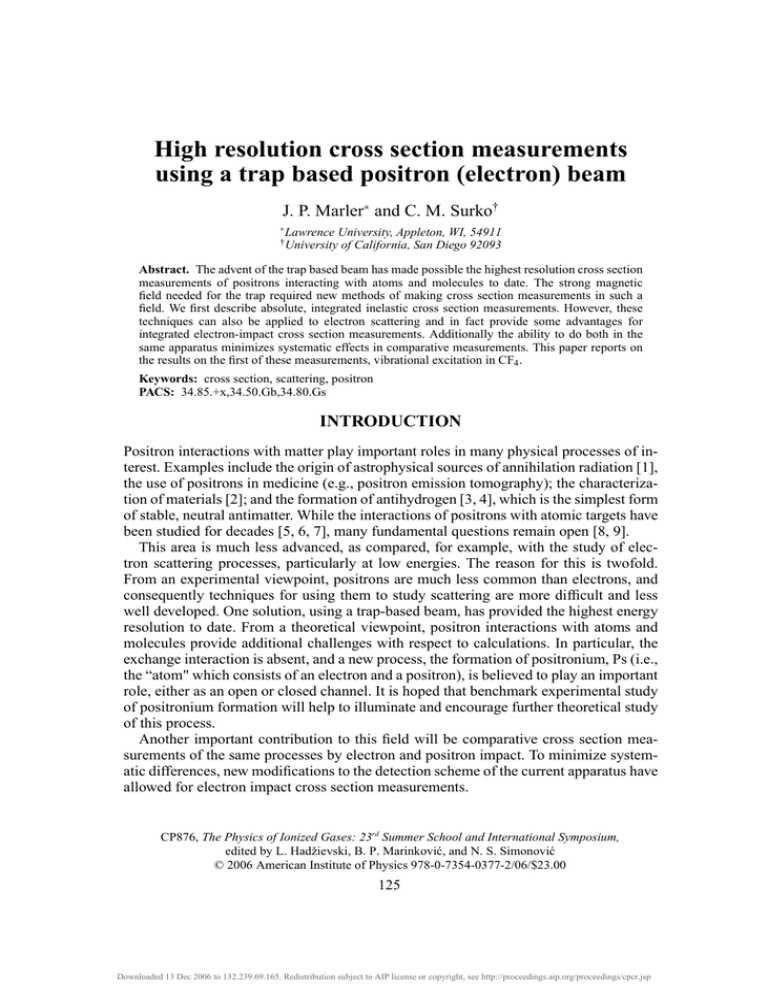
High resolution cross section measurements using a trap based positron (electron) beam J. P. Marler∗ and C. M. Surko† ∗ † Lawrence University, Appleton, WI, 54911 University of California, San Diego 92093 Abstract. The advent of the trap based beam has made possible the highest resolution cross section measurements of positrons interacting with atoms and molecules to date. The strong magnetic field needed for the trap required new methods of making cross section measurements in such a field. We first describe absolute, integrated inelastic cross section measurements. However, these techniques can also be applied to electron scattering and in fact provide some advantages for integrated electron-impact cross section measurements. Additionally the ability to do both in the same apparatus minimizes systematic effects in comparative measurements. This paper reports on the results on the first of these measurements, vibrational excitation in CF4 . Keywords: cross section, scattering, positron PACS: 34.85.+x,34.50.Gb,34.80.Gs INTRODUCTION Positron interactions with matter play important roles in many physical processes of interest. Examples include the origin of astrophysical sources of annihilation radiation [1], the use of positrons in medicine (e.g., positron emission tomography); the characterization of materials [2]; and the formation of antihydrogen [3, 4], which is the simplest form of stable, neutral antimatter. While the interactions of positrons with atomic targets have been studied for decades [5, 6, 7], many fundamental questions remain open [8, 9]. This area is much less advanced, as compared, for example, with the study of electron scattering processes, particularly at low energies. The reason for this is twofold. From an experimental viewpoint, positrons are much less common than electrons, and consequently techniques for using them to study scattering are more difficult and less well developed. One solution, using a trap-based beam, has provided the highest energy resolution to date. From a theoretical viewpoint, positron interactions with atoms and molecules provide additional challenges with respect to calculations. In particular, the exchange interaction is absent, and a new process, the formation of positronium, Ps (i.e., the “atom" which consists of an electron and a positron), is believed to play an important role, either as an open or closed channel. It is hoped that benchmark experimental study of positronium formation will help to illuminate and encourage further theoretical study of this process. Another important contribution to this field will be comparative cross section measurements of the same processes by electron and positron impact. To minimize systematic differences, new modifications to the detection scheme of the current apparatus have allowed electron impact cross section measurements. CREDIT LINEfor(BELOW) TO BE INSERTED ON THE FIRST PAGE OF EACH PAPER CP876, The Physics of Ionized Gases: 23rd Summer School and International Symposium, edited by L. Hadžievski, B. P. Marinković, and N. S. Simonović © 2006 American Institute of Physics 978-0-7354-0377-2/06/$23.00 125 Downloaded 13 Dec 2006 to 132.239.69.165. Redistribution subject to AIP license or copyright, see http://proceedings.aip.org/proceedings/cpcr.jsp N 2 in e+ I II I II -4 -3 10 torr -6 10 torr 10 torr B=0. 15T e+ A V B C Z FIGURE 1. Schematic diagram of the three stage buffer gas trap (top) and the electric potential in the three regions (below). In the final stage where the plasma is stored there is the lowest gas pressure to minimize loss. Accumulator Scattering cell RPA BC BA Annihilation plate NaI detector V VC VA FIGURE 2. Schematic diagram of the experimental apparatus. Note that the magnetic field in the scattering cell and analyser can be varied independently. EXPERIMENTAL TECHNIQUES The design and operation of the trap has been described in more detail elsewhere [10]. Briefly, positrons emitted from a radioactive 22 Na source are initially cooled by interaction with the frozen (∼7 K) neon walls nearby. These slow (eV’s of energy) positrons are magnetically guided into the three stage buffer gas trap (see Fig. 1). The positrons lose energy via inelastic collisions with the N2 buffer gas. Adding a small (relative to the N2 ) amount of CF4 in the third stage decreases the necessary cooling time. The positrons cool to 25 meV in 0.1 s. Figure 2 is a schematic diagram of the scattering cell and retarding potential annalyser (RPA). Bunches of cooled positrons are pulsed out of the trap and magnetically guided through the rest of the apparatus. The magnetic field in the trap is quite sizeable (∼0.1 T) and therefore it would be a real challenge to extract the positrons from the magnetic field to use traditional electrostatic scattering techniques. New techniques were developed to 126 Downloaded 13 Dec 2006 to 132.239.69.165. Redistribution subject to AIP license or copyright, see http://proceedings.aip.org/proceedings/cpcr.jsp make the measurements in the magnetic field and several advantages over electrostatic techniques have been noted and exploited. A more in depth discussion of the procedure is given in Ref.[11]. Basically the energy of the positrons in the magnetic field can be divided into energy in the parallel direction (i.e. along the magnetic field lines) and energy in directions perpendicular to the magnetic field lines (i.e. the energy in the cyclotron motion around the magnetic field lines). The positrons are accelerated out of the trap with significant parallel energy but maintain their relatively small (∼25 meV FWHM) perpendicular energy. The beam is guided through the gas cell, and analyser and directed into an annihilation plate at the end of the vacuum chamber. The annihilation gamma rays are then detected with a NaI crystal. It is important to note that the retarding potential analyser only measures the parallel energy distribution of the positron beam. The ratio of the final parallel energy to its initial energy gives information about the scattering angle for elastic collisions taking place in the gas cell. The cross section measurements presented here were done using a technique that relies on the fact that the positron orbits are strongly magnetized [11, 12]. For the experiments described here, the magnetic field in the scattering region, BS , and in the analyzing region, BA , can be adjusted independently. When BS BA , the invariance of the quantity, ξ = E⊥ /B (where E⊥ is the energy in the particles cyclotron motion) allows us to measure the approximate total positron energy using the RPA [12, 11]. In practice, we lower the magnetic field in the analyzing area thereby lowering the component in the perpendicular direction and transferring that energy into the parallel component. This in essence makes the parallel component approximately equal to the final total energy of the particles. The ratio of particles losing energy corresponding losing exactly the energy of certain inelastic processes to the initial beam strength determines the cross section for that process. The gas cell has been specially designed with small entrance and exit apertures so that the effective path length of the collisions. This allows us to make absolute cross section measurements with no fitted parameters. Adaptations for making electron measurements Secondary electrons are emitted in the source region. If the source is biased negatively, the electrons (and not the positrons) are directed towards the trap guided by the magnetic field lines. The electrons can be cooled and trapped in the same three stage buffer gas trap simply by reversing the potential on the electrodes. The detection scheme was altered to allow for electron measurements. The previous annihilation gamma ray detector was replaced with a charged particle diode internal to the vacuum chamber [13]. Since it does not depend on annihilation gammas, the charged particle detector works with particles of either sign. IONIZATION RESULTS Using the above techniques results in positron impact vibrational excitation [14], electronic excitation [15], positronium formation, and ionization [16, 17] have been made 127 Downloaded 13 Dec 2006 to 132.239.69.165. Redistribution subject to AIP license or copyright, see http://proceedings.aip.org/proceedings/cpcr.jsp 14 12 Direct Ionization CO N2 O2 10 Positronium Formation CO N2 O2 10 Cross section (units of a02) Cross section (units of a02) 12 8 6 4 2 0 8 6 4 2 0 0 10 20 30 40 50 60 70 80 90 0 Energy (eV) 10 20 30 40 50 60 70 80 90 Energy (eV) FIGURE 3. Integral cross sections for the direct ionization and positronium formation of CO, N2 and O2 respectively. Vertical bars mark the positions of the thresholds for O2 , CO and N2 respectively.[17] in a variety of atoms and molecules. (Differential cross sections and total cross sections have also been made in the same apparatus, see Ref. [11] for more details.) I chose to highlight the most recent results in ionization as it may be of particular interest to this community. Note that in positron scattering there are multiple processes which result in ionization. Direct ionization is the analogue to ionization by electrons and has the same threshold. However, positronium formation is also possible. In this process the positron ionizes the atom or molecule but remains bound to the ionized electron as a positronium atom. The binding energy of the positronium atom is 6.8 eV (1/2 that of the hydrogen atom) and therefore the threshold for this process is 6.8 eV less than the electron ionization threshold. A final possibility is the direct annihilation of the positron on one of the electrons of the atom or molecule. This process is also under investigation [18] but the cross sections for direct annihilation are orders of magnitude smaller than either direct ionization or positronium formation at the energies studied and can be ignored in these measurements. Figure 3 shows a comparison of the direct ionization and positronium formation cross sections for N2 ,CO and O2 . For a more comprehensive examination of these results see Ref [17]. The isoelectronic molecules N2 and CO have similar positronium formation and ionization cross sections as might be expected. However, the positronium formation cross section for O2 is qualitatively different near threshold from those for N2 and CO. The characteristic shape of the near-threshold feature in O2 has qualitative similarities to a feature observed previously in the total ionization cross section for O2 in this region of energies [19]. This feature is not fully understood and warrants further examination. ELECTRON AND POSITRON VIBRATIONAL CROSS SECTIONS Study of electron-CF4 interactions is important in many plasma-assisted materialprocessing applications as well as in space and atmospheric sciences [26]. We report here the first direct integral measurements of this electron-impact cross section. There have been previous, systematic comparisons of total and differential elastic cross sec- 128 Downloaded 13 Dec 2006 to 132.239.69.165. Redistribution subject to AIP license or copyright, see http://proceedings.aip.org/proceedings/cpcr.jsp 2 Cross section (units of a0 ) 30 25 20 15 10 5 0 0.0 0.2 0.4 0.6 0.8 1.0 1.2 1.4 1.6 1.8 2.0 2.2 E nergy (eV ) FIGURE 4. Integral electron-impact vibrational excitation of the ν3 vibrational mode of CF4 : (◦) current data [13]and (M) results of [20] scaled by a factor of 0.7 as suggested in Ref. [21]. Shown for comparison (•) are the current positron-impact results [13]. Also shown are (—) the results of an analytic, Born-dipole approximation calculation for the cross section [22], using infrared measurements to fix the dipole strength, Mdn ; and () [23] the Born model, fixing Mdn using electron differential scattering cross section measurements. Shown by the (♦) symbol is the result of a recent local interaction potential calculation for electron impact [24]. tions for electrons and positrons [27, 28, 29, 25]. There have also been reported positron cross section measurements for the sum of excitation to the three vibrational modes in CO2 [25]. The experiments reported here, on the other hand, are capable of sufficiently high energy resolution to measure state-resolved, integral inelastic cross sections, and to perform these state-selective measurements for both electrons and positrons in the same apparatus in order to minimize systematic differences. Figure 4 shows the result for the vibration excitation of the ν3 mode in CF4 [13]. The positron cross section is the largest positron vibrational cross section seen to date. This may explain on how adding CF4 in the the third stage of the trap is effective in reducing the cooling time. Also noticeable is how similar the positron and electron impact cross sections are to each other. A comparison of the Born Dipole Model with measured cross sections for both positron and electron impact excitation of the ν3 vibrational mode of CF4 ,CO, CH4 and CO2 has recently been presented in Ref. [30]. For the targets studied thus far that have nonzero transition dipole moments, the shapes of the Born-dipole cross sections are in fair agreement with the measurements. For example, shown in Fig. 5 is a comparison of the Born model with data for the ν3 mode of CO2 [14]. In this case, the Born dipole prediction accounts for about 60% of the measured value and has a shape virtually identical to that measured. 129 Downloaded 13 Dec 2006 to 132.239.69.165. Redistribution subject to AIP license or copyright, see http://proceedings.aip.org/proceedings/cpcr.jsp 2 Cross section (units of a0 ) 8 6 4 2 0 0 2 4 6 E nergy (eV ) FIGURE 5. Comparison of (•) the integral positron-impact cross section for vibrational excitation of the ν3 mode of CO2 [14] with the predictions of the Born dipole model. Shown are (—) the results of an analytic, Born-dipole calculation, (− −) the Born-dipole calculation scaled by a factor of 1.6, and (− · −) a calculation for positron-impact using a close coupling and continuum multiple scattering approach [25]. This comparison indicates that the predictions of the long-range dipole-coupling model can account for both the shape and much of the magnitude of the observed cross section. OUTLOOK The advent of the buffer gas trap has allowed for high resolution measurements of positron and electron cross section measurements. However, to date the resolution is limited to ∼ 25 meV. This limits near threshold measurements and low energy closely spaced inelastic cross sections (e.g. rotational excitation). Current work towards obtaining even finer energy resolution includes the construction of a 5 T superconducting PenningMalmberg trap [31]. This field is strong enough to allow the positrons to cool by cyclotron radiation and therefore eliminates the need for buffer gas cooling. Cryogenic electrodes (∼10K) in the trap will allow for lower energy beams. We also note of great interest to this group is the measurement of direct annihilation cross sections. These measurements also currently use the buffer gas trap as a source of low energy positron pulses and could also benefit by an improved (i.e. lower energy with a more narrow energy spread) beam. Current progress on these results are described in Refs. [18, 32] ACKNOWLEDGMENTS This work is supported by the National Science Foundation. REFERENCES 1. N. Guessoum, R. Ramaty, and R. E. Lingenfelter, Astrophysical Journal 378, 170 (1991). 130 Downloaded 13 Dec 2006 to 132.239.69.165. Redistribution subject to AIP license or copyright, see http://proceedings.aip.org/proceedings/cpcr.jsp 2. 3. 4. 5. 6. 7. 8. 9. 10. 11. 12. 13. 14. 15. 16. 17. 18. 19. 20. 21. 22. 23. 24. 25. 26. 27. 28. 29. 30. 31. 32. L. D. Hulett, Jr., D. L. Donohue, J. Xu, T. A. Lewis, S. A. McLuckey, and G. L. Glish, Chemical Physics Letters 216, 236–40 (1993). M. A. et al., Nature 419, 456 – 459 (2002). G. G. et al., Physical Review Letters 89, 213401 (2002). T. C. Griffith, and G. R. Heyland, Physics Reports 39, 169 (1978). W. E. Kauppila, and T. S. Stein, Advances in Atomic, Molecular, and Optical Physics 26, 1 – 49 (1990). M. Charlton, and J. Humberston, Positron Physics, Cambridge University Press, New York, 2001. C. M. Surko, and F. A. Gianturco, editors, New Directions in Antimatter Chemistry and Physics, Kluwer Academic Publishers, Dordrecht, 2001. C. M. Surko, G. F. Gribakin, and S. J. Buckman, Journal of Physics B 38, R57–126 (2005). S. J. Gilbert, C. Kurz, R. G. Greaves, and C. M. Surko, Applied Physics Letters 70, 1944–1946 (1997). J. P. Sullivan, S. J. Gilbert, J. P. Marler, R. G. Greaves, S. J. Buckman, and C. M. Surko, Physical Review A 66, 042708 (2002). S. J. Gilbert, R. G. Greaves, and C. M. Surko, Physical Review Letters 82, 5032–5035 (1999). J. P. Marler, and C. M. Surko, Physical Review A 72, 062702 (2005). J. P. Sullivan, S. J. Gilbert, and C. M. Surko, Physical Review Letters 86, 1494 (2001). J. P. Sullivan, J. P. Marler, S. J. Gilbert, S. J. Buckman, and C. M. Surko, Physical Review Letters 87, 073201 (2001). J. P. Marler, J. P. Sullivan, and C. M. Surko, Physical Review A 71, 022701 (2005). J. P. Marler, and C. M. Surko, Physical Review A 72, 062713 (2005). L. D. Barnes, S. J. Gilbert, and C. M. Surko, Physical Review A 67, 032706 (2003). G. Laricchia, J. Moxom, and M. Charlton, Physical Review Letters 70, 3229–3230 (1993). M. Hayashi, “Electron collision cross sections for molecules determined from beam and swarm data,” in Swarm Studies and Inelastic Electron-Molecule Collisions, edited by L. C. P. et al., Springer, Berlin, 1987, pp. 167–87. L. E. Kline, and T. V. Congedo, Bull. Am. Phys. Soc. 34, 325 (1989). A. Mann, and F. Linder, Journal of Physics B 25, 545–556 (1992). R. A. Bonham, Japanese Journal of Applied Physics 33, 4157–4164 (1994). S. Irrera, and F. A. Ginaturco, New Journal of Physics 7, 1 (2005). M. Kimura, M. Takekawa, Y. Itikawa, H. Takaki, and O. Sueoka, Physical Review Letters 80, 3936– 3939 (1998). L. G. Christophorou, J. K. Olthoff, and M. V. V. S. Rao, Journal of Physical and Chemical Reference Data 25, 1341–1388 (1996). E. Surdutovich, W. E. Kauppila, C. K. Kwan, E. G. Miller, S. P. Prikh, K. A. Price, and T. S. Stein, Nuclear Instruments and Methods B 221, 97–99 (2004). S. Zhou, H. Li, W. E. Kauppila, C. K. Kwan, and T. S. Stein, Physical Review A 55, 361–368 (1997). C. Makochekanwa, M. Kimura, and O. Sueoka, Physical Review A 70, 022702 (2004). J. P. Marler, G. F. Gribakin, and C. M. Surko, Nuclear Instruments and Methods B 247, 87–91 (2005). J. R. Danielson, P. Schmidt, J. P. Sullivan, and C. M. Surko, “A Cryogenic, High-field Trap for Large Positron Plasmas and Cold Beams,” in Non-Neutral Plasma Physics V, edited by M. Schauer, T. Mitchell, and R. Nebel, AIP, New York, 2003, pp. 149–161. L. D. Barnes, J. A. Young, and C. M. Surko, Physical Review A 74, 012706 (2006). 131 Downloaded 13 Dec 2006 to 132.239.69.165. Redistribution subject to AIP license or copyright, see http://proceedings.aip.org/proceedings/cpcr.jsp
